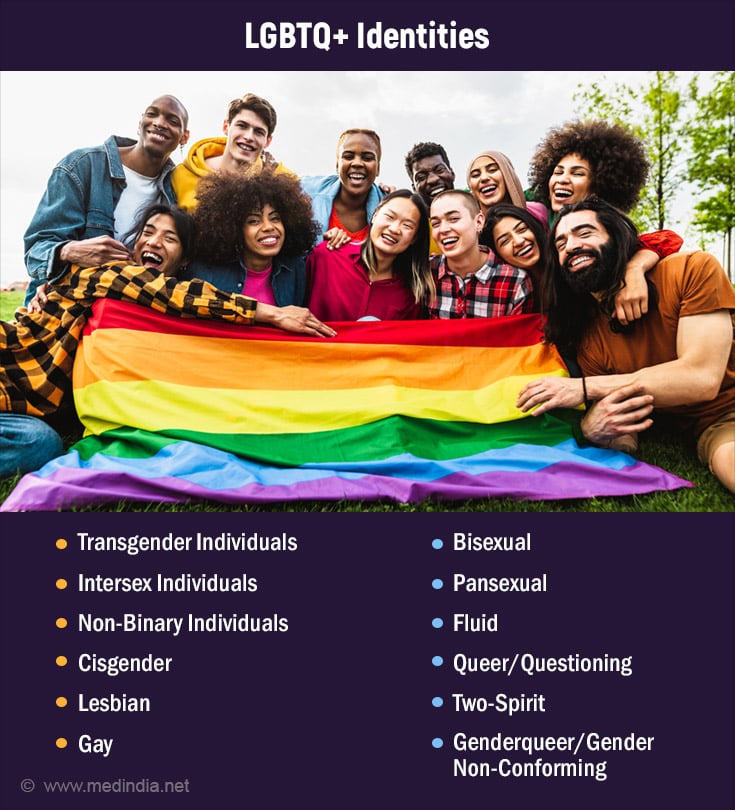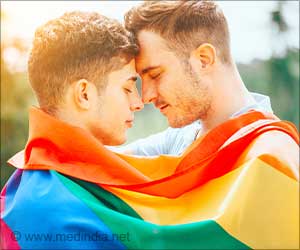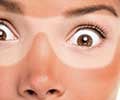- What Is LGBTQIA+? - (https://gaycenter.org/community/lgbtq/)
- Defining LGBTQ Terms and Concepts - (https://www.aecf.org/blog/lgbtq-definitions)
- The Health of Lesbian, Gay, Bisexual, and Transgender People: Building a Foundation for Better Understanding - (https://www.ncbi.nlm.nih.gov/books/NBK64810/)
- Sexual Orientation and Gender Identity - (https://youth.gov/youth-topics/lgbt)
- LGBTQ+ Communities and Mental Health - (https://mhanational.org/issues/lgbtq-communities-and-mental-health)
About
LGBTQ+ stands for Lesbian, Gay, Bisexual, Transgender, Queer, and the "+" symbolizes inclusion of other diverse sexual orientations, gender identities, and expressions.
The LGBTQ+ community encompasses individuals whose sexual orientations or gender identities diverge or different from the societal norms of heterosexual and cisgender identities. It cannot be denied that the LGBTQ+ people have historically faced discrimination, stigma, and marginalization, but despit all this, they have shown resilience, pride, and a vibrant sense of community(1✔ ✔Trusted Source
What Is LGBTQIA+?
Go to source).
In the current scenario, the LGBTQ+ movement advocates for equal rights, representation, and acceptance, striving to create a more inclusive and affirming society for all individuals regardless of their sexual orientation or gender identity.
LGBTQ+ Diversity
1. Transgender Individuals
Transgender individuals are those whose gender identity differs from the sex they were assigned at birth.
Trans Women: Assigned male at birth but identify and live as women.
Trans women may pursue feminizing surgeries such as vaginoplasty (creation of a vagina), breast augmentation, facial feminization surgery, and voice feminization surgery to affirm their gender identity.
Trans Men: Assigned female at birth but identify and live as men. Trans men may undergo masculinizing surgeries such as chest reconstruction (removal of breast tissue), hysterectomy (removal of the uterus), and phalloplasty or metoidioplasty (creation of a penis) to align their bodies with their gender identity.
Did You Know?
The Rainbow Flag is a Symbol of Pride #lgbtq+ #pride #medindia2. Intersex Individuals
Intersex refers to people who are born with physical sex traits, like chromosomes, reproductive organs, or genitals, that don't fit the usual categories of male or female.
Intersex individuals can also be transgender if their gender identity does not match the sex they were assigned at birth. Some may feel distress or discomfort, known as gender dysphoria, due to this mismatch. They might seek gender-reassignment surgery to help their physical appearance match their gender identity(2✔ ✔Trusted Source
Defining LGBTQ Terms and Concepts
Go to source).
Types of Intersex Variations:
Understanding our Chromosome and their function: Each cell in the human body has threadlike structures within the nucleus of the cell called Chromosomes. These threadlike structures carry our genomic information within the DNA and pass it on from cell to cell when it divides or multiplies.
Humans have 23 pairs of chromosomes (a total of 46) of which 22 are called autosomes but one pair determines our sex and is called sex chromosomes. Females have two X chromosomes or XX and male have one X and another Y chromosome or XY). Of the two chromosomes, one comes from each parent, which means that children inherit half of their chromosomes from their mother and half from their father.
Chromosomal variations: Some intersex variations involve differences in sex chromosomes, there can be an extra X chromosome - such as XXY (called Klinefelter syndrome) or just one X chromosome or XO (called Turner syndrome). These variations affect sexual development and lead to differences in physical traits and characteristics.
Genital: Intersex variations can also involve differences in genitalia, such as ambiguous genitalia, where the external genitals do not clearly resemble typical male or female anatomy. Other variations may include incomplete development of reproductive organs or variations in size and shape.
Hormonal: Hormonal variations can affect the development of secondary sexual characteristics, such as breast development, facial hair growth, or voice pitch. Hormonal imbalances may result from conditions such as congenital adrenal hyperplasia (CAH) or androgen insensitivity syndrome (AIS).
Individuals with Klinefelter Syndrome
Klinefelter syndrome as mentioned previously is characterized by the presence of an extra X chromosome (XXY) in individuals with male anatomy. This genetic variation affects sexual development and can lead to a range of physical and medical characteristics.
Physical Characteristics:
Sexual Development: Individuals with Klinefelter syndrome may experience differences in sexual development, including reduced levels of testosterone and sperm production, which can lead to infertility. They may also have smaller testes and penis size compared to typical males.
Physical Traits: Klinefelter syndrome can manifest in physical characteristics such as tall stature, longer limbs, reduced muscle mass, and increased body fat. Some individuals may develop gynecomastia, or enlarged breast tissue, during puberty or adulthood.(3✔ ✔Trusted Source
The Health of Lesbian, Gay, Bisexual, and Transgender People: Building a Foundation for Better Understanding
Go to source)
Individuals with Turner Syndrome
Turner syndrome is a chromosomal condition that affects females, characterized by the complete or partial absence of one of the two X chromosomes (45,X or 45,X/46,XX mosaicism). This genetic variation leads to a range of physical and medical characteristics.
Physical Characteristics
Sexual Development: Individuals with Turner syndrome typically experience incomplete sexual development, including ovarian insufficiency or premature ovarian failure, which can lead to infertility.
They may have underdeveloped secondary sexual characteristics, such as smaller breasts and less pubic hair, and may not experience a menstrual cycle without hormonal treatment.
Physical Traits: Individuals with Turner syndrome often exhibit distinctive physical traits, including shorter than average height, a broad or webbed neck, and a low hairline at the back of the neck. Lymphedema, or swelling of the hands and feet, is particularly noticeable at birth.
They may have a higher incidence of skeletal abnormalities like scoliosis and other anomalies. Structural abnormalities in the kidneys can occur, though they typically do not impair function. Additionally, there is a higher risk of congenital heart defects such as bicuspid aortic valve or coarctation of the aorta.
Medical and Developmental Issues: Individuals with Turner syndrome often require hormonal treatment, such as growth hormone therapy to increase height in childhood and estrogen replacement therapy during adolescence to develop secondary sexual characteristics.
Although their intelligence is typically normal, they may face specific learning difficulties, especially in mathematics and spatial reasoning, along with social challenges in interactions and nonverbal communication. Regular medical monitoring is crucial to manage associated health risks, including hypothyroidism, diabetes, and osteoporosis.

3. Non-Binary Individuals
"Non-binary" is a term used to describe individuals whose gender identity does not exclusively align with the categories of male or female. This is a deeply personal and internal sense of one's own gender. Non-binary individuals may identify as both, neither, a combination of both, or as a gender entirely different from male or female.
4. Cisgender
Cisgender is a term used to describe individuals whose gender identity aligns with the sex they were assigned at birth. In other words, someone who is cisgender identifies as the gender typically associated with the biological sex they were born with. For example, a person who was assigned female at birth and identifies as a woman is considered cisgender.
5. Lesbian
Lesbian individuals are women who are attracted romantically, emotionally, and/or sexually to other women. This attraction can encompass a wide range of experiences and expressions, from deep emotional connections to physical intimacy.
Lesbian identities are diverse and multifaceted, encompassing a spectrum of experiences and expressions. Some lesbians may identify with specific subcultures within the community, such as butch, femme, or lipstick lesbian, while others may eschew labels altogether. These terms reflect different styles of gender expression and personal identity within the lesbian community.
Identity Variation:
Butch: Butch lesbians typically present themselves in a more masculine manner, embracing traits traditionally associated with masculinity such as short haircuts, masculine clothing, and assertive behavior. However, butch identity is not solely defined by outward appearance but also by a deeply felt sense of self that may include characteristics like strength, confidence, and independence.
Femme: Femme lesbians often embrace a more traditionally feminine presentation, including dresses, makeup, and other elements of feminine expression. Femme identity celebrates femininity and may challenge stereotypes about what it means to be a lesbian, demonstrating that sexual orientation and gender expression are not inherently linked.
Lipstick Lesbian: Lipstick lesbians combine elements of both femininity and queerness, embracing traditionally feminine presentation while also expressing attraction to women. The term "lipstick lesbian" challenges stereotypes by highlighting that lesbian identity is not limited to one particular style or expression.
6. Gay
Gay individuals are men who are attracted romantically, emotionally, and/or sexually to other men. This attraction can encompass a wide range of experiences and expressions, from deep emotional connections to physical intimacy.
Gay identities are diverse and multifaceted, reflecting the complexity of human sexuality and personal expression. Some gay men may identify with specific subcultures within the community, while others may embrace a more fluid or undefined sense of identity. These identities can include variations such as:
Identity Variation:
Camp/Gay Camp: Camp culture is characterized by humor, theatricality, and exaggerated expression. Gay camp often celebrates kitsch, irony, and the subversion of traditional gender norms. It has been a significant cultural influence within the gay community, particularly in art, fashion, and entertainment.
Bear/Chub: Bear culture celebrates masculinity and body positivity, often emphasizing physical attributes such as body hair, muscle, and size. Bears and chubs may gather in social spaces known as bear bars or bear events, fostering camaraderie and connection within the community.
Twink: Twink culture embraces youthfulness, slender physique, and often a more effeminate or androgynous presentation. Twinks may be celebrated for their youthful energy, beauty, and sexual appeal within the gay community.
7. Bisexual
Bisexual individuals are those who are attracted romantically, emotionally, and/or sexually to people of more than one gender. This attraction can encompass a wide range of experiences and expressions, from deep emotional connections to physical intimacy, with individuals of both the same and different genders.
Bisexuality challenges the binary understanding of sexuality, which traditionally posits that individuals are exclusively attracted to either men or women. Instead, bisexuality emphasizes fluidity and complexity, recognizing that sexual orientation exists on a spectrum and can evolve over time.
Bisexual identities are diverse and multifaceted, reflecting the complexity of human sexuality and personal expression. Some bisexual individuals may identify with specific subcultures within the community, while others may embrace a more fluid or undefined sense of identity.
8. Pansexual: Pansexuality expands upon bisexuality by emphasizing attraction to people of all genders, not just male and female. Pansexual individuals may experience attraction based on factors beyond gender, such as personality, character, or emotional connection.
9. Fluid: Fluidity refers to the idea that sexual orientation can change or shift over time. Fluid individuals may experience fluctuations in attraction, finding themselves attracted to different genders at different points in their lives.
10. Queer/Questioning
"Queer" is an umbrella term used to describe individuals whose sexual orientation or gender identity falls outside societal norms. Historically, "queer" was used as a pejorative term to marginalize and oppress LGBTQ+ individuals.Queer identity is often characterized by fluidity and flexibility, transcending rigid categories of sexual orientation and gender identity.
"Questioning" refers to individuals who are exploring their sexual orientation or gender identity. Questioning individuals may be uncertain about their attractions, feelings, or identity, and may be in the process of self-discovery and exploration.
11. Two-Spirit
The term "Two-Spirit" originates from Indigenous cultures in North America and is used to describe individuals who embody both masculine and feminine qualities or roles.
Two-Spirit individuals have historically held significant roles within Indigenous communities, often serving as healers, counselors, or mediators.
12. Genderqueer/Gender Non-Conforming
Genderqueer: Genderqueer individuals are those who reject or transcend traditional binary gender categories, embracing a fluid or non-binary understanding of gender. They may identify with neither, both, or a combination of male and female genders, or with a gender entirely different from male or female.
Gender Non-Conforming: Gender non-conforming individuals are those whose gender expression does not conform to societal expectations or norms associated with their assigned sex at birth. This can include appearance, behavior, dress, and other aspects of gender presentation(4✔ ✔Trusted Source
Sexual Orientation and Gender Identity
Go to source).
Relationship Structures
Asexual
Asexuality is a sexual orientation characterized by experiencing little to no sexual attraction to others. Asexual individuals may not feel the same desire for sexual intimacy as those who identify with other sexual orientations.
Despite experiencing little to no sexual attraction, many asexual individuals still experience romantic attraction.
Aromantic
Aromanticism is a romantic orientation characterized by experiencing little to no romantic attraction to others. Aromantic individuals may not feel the same desire for romantic relationships or connections as those who identify with other romantic orientations.
Despite experiencing little to no romantic attraction, many aromantic individuals may still desire and form deep emotional connections with others, and many still experience sexual attraction. These connections may resemble friendships or other close relationships.
Polyamorous/Non-Monogamous:
Polyamory/Non-Monogamous is the practice of engaging in consensual, ethical relationships with multiple partners simultaneously. These relationships may involve emotional intimacy, romantic connections, and/or sexual relationships.Primary/Secondary Partnerships: Some polyamorous relationships may involve hierarchical structures, where individuals have primary and secondary partners. Primary partners may share certain commitments or life decisions, while secondary partners may have a more casual or limited role.
Triads/Quads: Triads and quads refer to relationships involving three or four individuals, respectively, who are all romantically and/or sexually involved with each other. These configurations may vary in dynamics and commitments.
Solo Polyamory: Solo polyamory emphasizes autonomy and independence, with individuals maintaining multiple relationships while prioritizing their individual needs and goals. This approach challenges traditional notions of couple-centric relationships.
Relationship Anarchy: Relationship anarchy rejects hierarchical structures and societal norms, emphasizing the autonomy of individuals to define and negotiate their own relationships on their terms. This approach prioritizes fluidity, flexibility, and personal agency.
LGBTQ+ Health and Well-being
Mental Health
LGBTQ+ individuals face higher rates of mental health issues, including depression, anxiety, and suicidality, due to discrimination, stigma, and minority stress. Culturally competent mental health services and community support are essential for addressing these disparities and promoting well-being(5✔ ✔Trusted Source
LGBTQ+ Communities and Mental Health
Go to source).
Sexual Health
Sexual health education, access to healthcare, and HIV/AIDS prevention are critical issues for LGBTQ+ communities. Comprehensive sexual health services, including testing, prevention, and treatment, help reduce the spread of sexually transmitted infections and support sexual well-being for all individuals.
Gender-Affirming Healthcare
Gender-affirming healthcare encompasses medical interventions, such as hormone therapy and gender-affirming surgeries, to align individuals' bodies with their gender identity. Access to affirming care is essential for transgender and non-binary people to live authentically and improve their quality of life.
Pride Month
Pride Month is the annual celebrations in June that honor LGBTQ+ history, culture, and achievements while advocating for equality and acceptance. Originating from the Stonewall Riots of 1969, Pride Month commemorates a pivotal moment in LGBTQ+ rights history.
Pride parades, held globally, feature colorful displays of LGBTQ+ pride and solidarity, with participants marching, dancing, and celebrating diversity.
Beyond festivities, Pride Month fosters reflection, education, and activism through events like panel discussions and workshops, uniting LGBTQ+ individuals and allies in advocacy for equality and justice.
LGBTQ+ Social Groups
LGBTQ+ social groups provide vital support, community, and advocacy for individuals within the LGBTQ+ community. These groups offer spaces for people to connect with others who share similar identities and experiences, fostering a sense of belonging and solidarity. They play a crucial role in promoting acceptance, visibility, and equality for LGBTQ+ individuals in society.
- Community Centers: LGBTQ+ community centers provide a range of services and resources, including support groups, counseling, educational workshops, and social events. They serve as safe and welcoming spaces for LGBTQ+ people to gather, access resources, and build community.
- Support Groups: Support groups offer a place for LGBTQ+ individuals to share their experiences, seek guidance, and receive support from others who understand their challenges. These groups may focus on specific issues such as coming out, mental health, substance abuse recovery, or transgender support.
- Social Clubs: Social clubs and organizations provide opportunities for LGBTQ+ people to socialize, make friends, and participate in recreational activities together. These clubs may organize events such as game nights, hiking trips, book clubs, or cultural outings.
- Activist Groups: Activist groups advocate for LGBTQ+ rights, visibility, and equality through grassroots organizing, political activism, and community outreach. These groups mobilize community members to participate in protests, lobbying efforts, educational campaigns, and fundraising initiatives.
- Religious and Faith-Based Groups: Some LGBTQ+ individuals seek community and spiritual support within religious or faith-based groups that affirm their identities and provide inclusive spaces for worship, fellowship, and discussion.
- Online Communities: With the rise of social media and digital communication platforms, many LGBTQ+ people connect and build communities online through forums, social networking sites, and virtual support groups. These online communities offer support, information, and connection to individuals who may not have access to LGBTQ+ resources in their local area.
Drag Performers
Drag Performers may or may not be a part of LGBTQ+ community but historically the culture of drag has a strong connection with the community, especially with the Gay community.
Drag performers are individuals who utilize clothing, makeup, and performance art to explore and celebrate gender expression. They typically associate themselves with a gender different from their own. These performers engage in drag for various reasons, including self-expression, artistic exploration, and entertainment purposes.
While some drag performers may identify as transgender or non-binary and use drag as a form of self-expression or exploration of their gender identity, others may identify as cisgender and engage in drag purely for entertainment or artistic expression.
Drag Queens and Drag Kings: Drag queens are typically male individuals who dress in feminine attire and adopt exaggerated female personas for performance. Drag kings, on the other hand, present as male or masculine while performing. While some drag performers may identify as transgender and may ultimately pursue gender-affirming surgeries, the act of performing drag does not inherently imply a desire for surgical intervention.
Notable Drag Performers
Rani Ko-He-Nur: Rani Ko-He-Nur, also known as Sushant Divgikar, is a prominent Indian drag performer, singer, and television personality. Competing in international drag competitions, Rani Ko-He-Nur advocates strongly for LGBTQ+ rights in India.
RuPaul Charles: RuPaul is the most famous drag performer globally, hosting and producing the hit TV show "RuPaul's Drag Race," which mainstreamed drag culture. With a successful music career and numerous film and TV appearances, RuPaul is a trailblazer and advocate for LGBTQ+ rights, inspiring many to embrace their true selves and fostering acceptance of drag culture worldwide.
 MEDINDIA
MEDINDIA

 Email
Email








